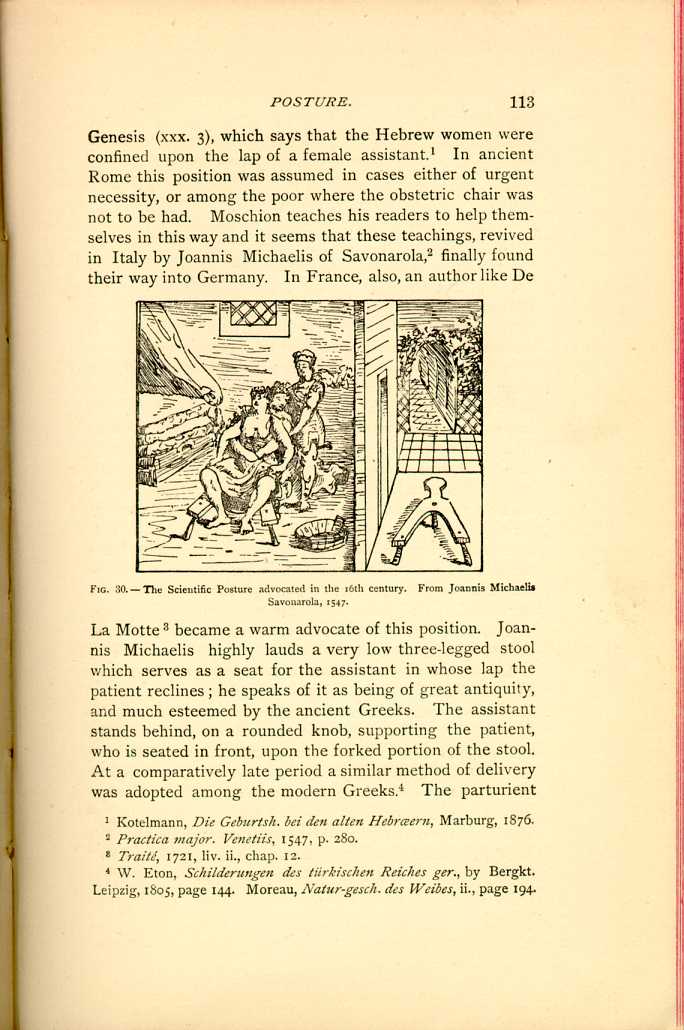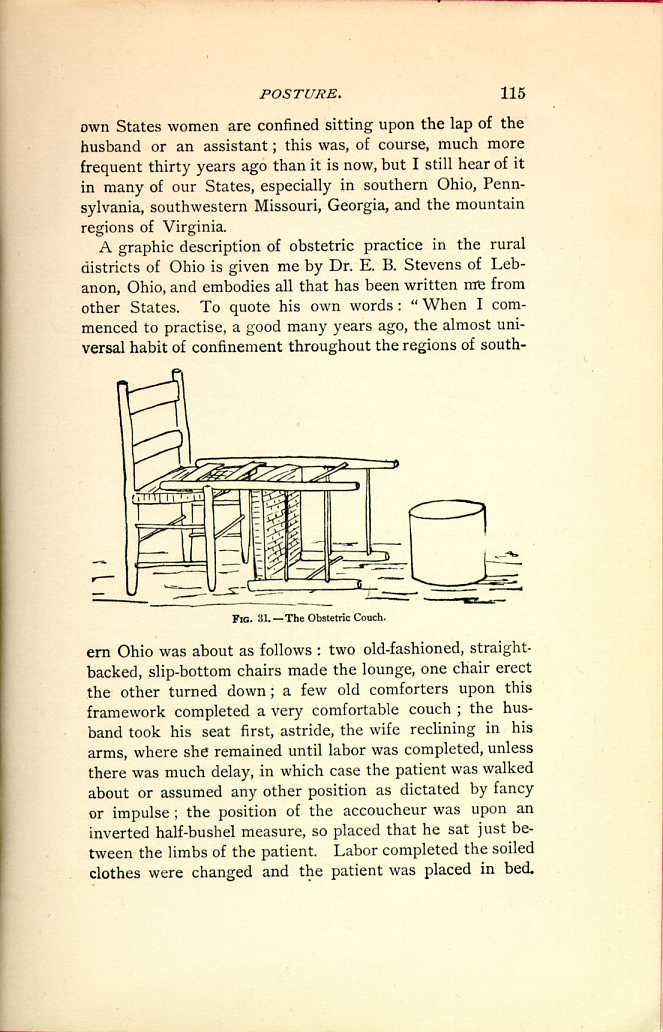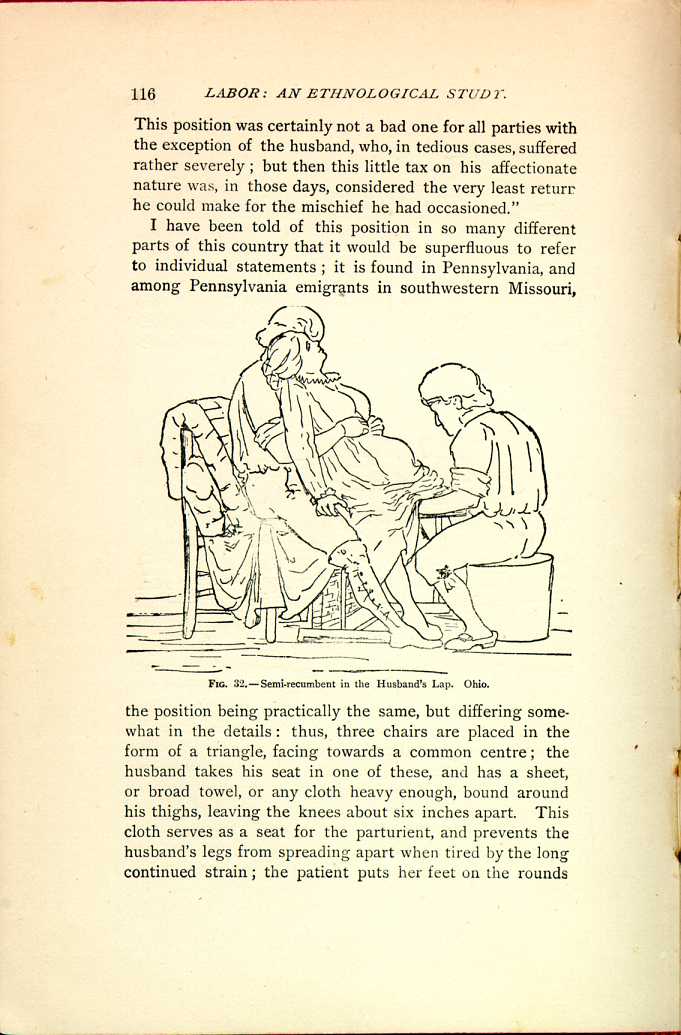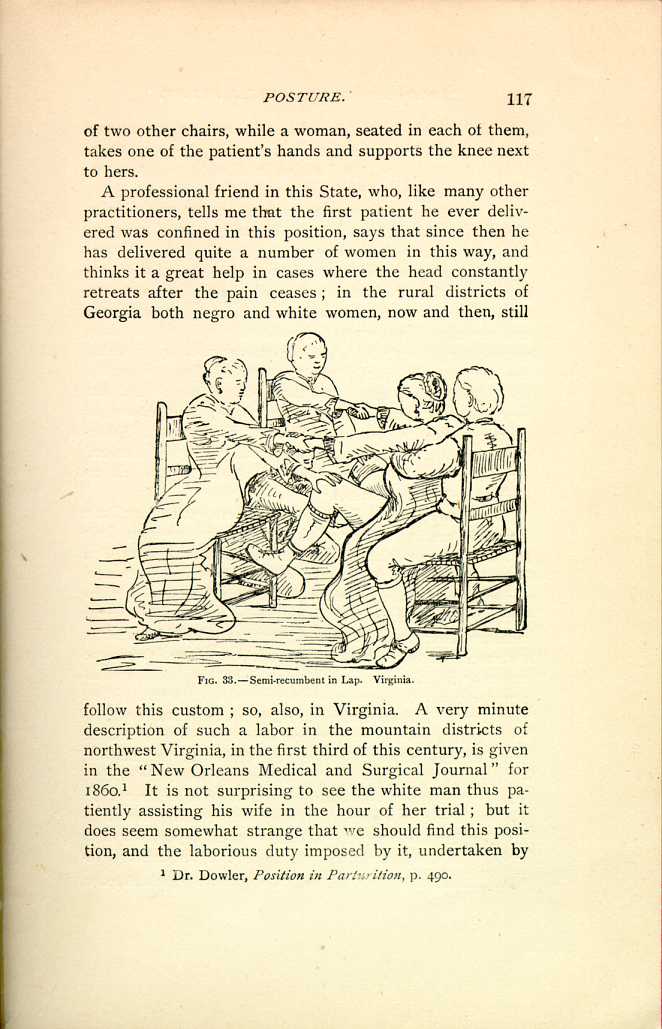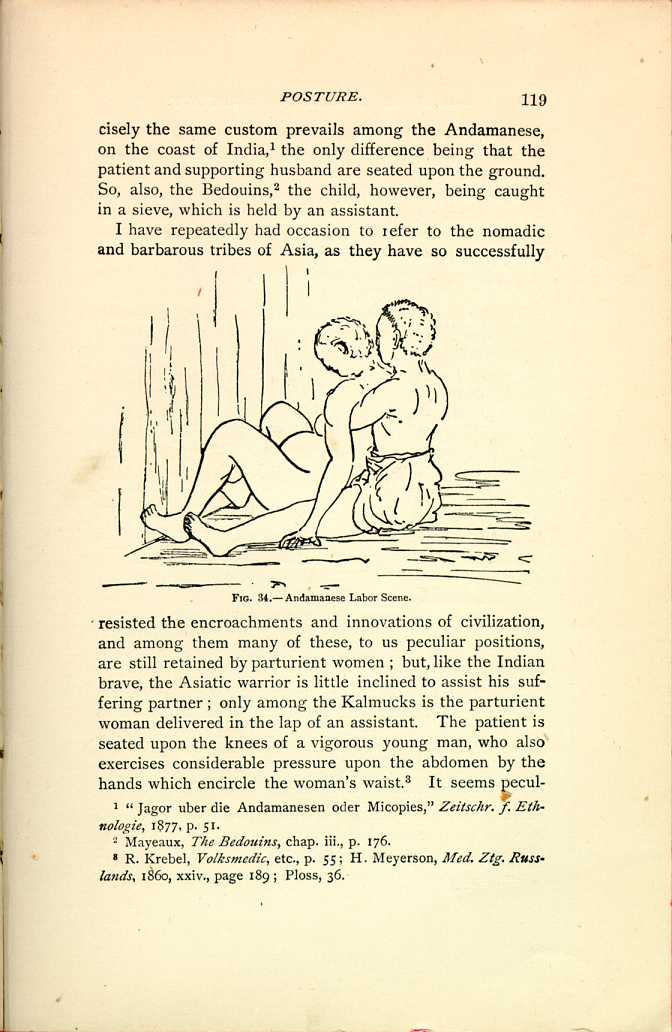(b.) Sitting on the Lap or between the Thighs of an Assistant
who is seated on a Chair or on the Floor.
I look upon this position as identical with that on the obstretric
chair, although more simple and more ancient; and
I believe that it will be apparent to every one, if the relative
positions are considered, that the obstetric chair is
merely an imitation of the more pliable and sensitive support
afforded by the husband or assistant, who is himself
made to suffer whilst holding the parturient woman during
the tedious hours of labor. I am heartily in accord with
the statement of Rigby, although seriously questioned by
Ploss, that, "as far as we may rely upon the meagre records
which history gives us upon this subject, among the more
civilized people of antiquity the semi-recumbent sitting posture
was by far the most common. In proof of this I will
again refer to the oft-mentioned funeral urn which so vividly
pictures the position of patient, husband, and nurse in the
lying-in chamber during the moment of the greatest trial,
during the expulsion of the child. The patient is seated in
the lap of an assistant. I can hardly say whether this is
the husband or a female assistant, whether it is a male or
female figure; at all events she is seated in the lap of a person
whose arms encircle her waist, the hands pressing firmly
upon the fundus of the uterus. The midwife is seated upon
a low stool, between the separated legs of the patient, and is
just in the act of receiving the head of the new-born child.
This vessel, called
Huaco, represents a parturient scene precisely
as it is still enacted among the descendants of the
Incas to this day, and Dr. Coates assures me that he has,
during his stay in Peru, not unfrequently acted accoucheur,
the woman always taking this position with the husband
behind. Upon that entire coast of South America the
inhabitants seem faithfully to adhere to the customs of their
ancestors, and no better proof can be found of the correctness
of the representation of the labor scene depicted upon
this vessel than the above statement of Dr. Coates, and of
other physicians, the most interesting of which is perhaps
one by Dr. Ruschenberger,
[100]
who, whilst in Colina, in Chili,
in 1823, was called to a case of placenta previa and found
a lady, a lady of rank by the way, with her feet near the
foot of the bed, the knees drawn up, reclining against her
husband, a rather short corpulent man, who was sitting in
the middle of the bed wearing his riding cap, booted and
spurred, with the legs extended on each side of her and his
hands clasped in front of her chest to afford support. The
antiquity of this position is also proven by a passage in
Genesis (xxx. 3), which says that the Hebrew women were
confined upon the lap of a female
assistant.
[101]
In ancient
Rome this position was assumed in cases either of urgent
necessity, or among the poor where the obstetric chair was
not to be had. Moschion teaches his readers to help themselves
in this way and it seems that these teachings, revived
in Italy by Joannis Michaelis of
Savonarola,
[102] finally found
their way into Germany. In France, also, an author like De
La Motte
[103]
became a warm advocate of this position. Joannis
Michaelis highly lauds a very low three-legged stool
which serves as a seat for the assistant in whose lap the
patient reclines; he speaks of it as being of great antiquity,
and much esteemed by the ancient Greeks. The assistant
stands behind, on a rounded knob, supporting the patient,
who is seated in front, upon the forked portion of the stool.
At a comparatively late period a similar method of delivery
was adopted among the modern Greeks.
[104]
The parturient
woman being seated upon a kind of tripod, behind her upon
a somewhat higher stool sits an assistant whose arms are
clasped over the fundus of the womb whilst the midwife is
seated in front. I regard these positions as in the lap of an
assistant and can certainly not look upon a simple stool, as
it was probably found in any kitchen at the time, as an obstetric
chair, but from that, most unquestionably, the obstetric
chair takes its origin, and a very pointed statement
to this effect is made by Dr. Metzler,
[105]
who in the early part
of this century found an obstetric chair in some remote village
where he little expected to see it, which had been constructed
by a carpenter who had neither seen an obstetric
chair nor heard of one; but his wife had found her labor
so easy, while sitting upon his lap, his legs separated, that
he soon obtained a reputation in his native village, so that
finally not a woman in the place would be confined in any
other way than upon this good man's lap; this he soon
found so irksome that he constructed this chair, and, in his
endeavors to copy the position assumed by himself, a very
fair obstetric chair resulted.
[106]
The above also seems to verify
the statement that certain persons seem especially fitted,
and acquire a reputation for such work; in Holland they
were a regular convenience at every labor, and were known
as "shootsteers;'' but not only here and there in Germany,
in France or Holland, but also among the early Scotch,
Welsh, and English was this position frequently resorted to,
and we need not be astonished to see this same custom in
our own country.
We have seen how the modern Peruvians still follow the
ways of the Incas, and so the descendants of these Germans,
Welsh, or Scotch have not forgotten the habits of
their ancestors, although they have crossed the seas and
have mingled with a more enlightened civilization. It may
surprise some of our city practitioners of to-day, who see
little of the country population, and especially those who
have not practiced in rural districts years ago, that in our
own States women are confined sitting upon the lap of the
husband or an assistant; this was, of course, much more
frequent thirty years ago than it is now, but I still hear of it
in many of our States, especially in southern Ohio, Pennsylvania,
southwestern Missouri, Georgia, and the mountain
regions of Virginia
A graphic description of obstetric practice in the rural
districts of Ohio is given me by Dr. E. B. Stevens of Lebanon,
Ohio, and embodies all that has been written me from
other States. To quote his own words: "When I commenced
to practice, a good many years ago, the almost universal
habit of confinement throughout the regions of southern
Ohio was about as follows: two old-fashioned, straight-backed,
slip-bottom chairs made the lounge, one chair erect
the other turned down; a few old comforters upon this
framework completed a very comfortable couch; the husband
took his seat first, astride, the wife reclining in his
arms, where she remained until labor was completed, unless
there was much delay, in which case the patient was walked
about or assumed any other position as dictated by fancy
or impulse; the position of the accoucheur was upon an
inverted half-bushel measure, so placed that he sat just between
the limbs of the patient. Labor completed the soiled
clothes were changed and the patient was placed in bed.
This position was certainly not a bad one for all parties with
the exception of the husband, who, in tedious cases, suffered
rather severely; but then this little tax on his affectionate
nature was, in those days, considered the very least return
he could make for the mischief he had occasioned.''
I have been told of this position in so many different
parts of this country that it would be superfluous to refer
to individual statements; it is found in Pennsylvania, and
among Pennsylvania emigrants in southwestern Missouri,
the position being practically the same, but differing somewhat
in the details: thus, three chairs are placed in the
form of a triangle, facing towards a common centre; the
husband takes his seat in one of these, and has a sheet,
or broad towel, or any cloth heavy enough, bound around
his thighs, leaving the knees about six inches apart. This
cloth serves as a seat for the parturient, and prevents the
husband's legs from spreading apart when tired by the long
continued strain; the patient puts her feet on the rounds
of two other chairs, while a woman, seated in each of them,
takes one of the patient's hands and supports the knee next
to hers.
A professional friend in this State, who, like many other
practitioners, tells me that the first patient he ever delivered
was confined in this position, says that since then he
has delivered quite a number of women in this way, and
thinks it a great help in cases where the head constantly
retreats after the pain ceases; in the rural districts of
Georgia both negro and white women, now and then, still
follow this custom; so, also, in Virginia. A very minute
description of such a labor in the mountain districts of
northwest Virginia, in the first third of this century, is given
in the "New Orleans Medical and Surgical Journal'' for
1860.[107]
It is not surprising to see the white man thus
patiently assisting his wife in the hour of her trial; but it
does seem somewhat strange that we should find this position,
and the laborious duty imposed by it, undertaken by
our red brethren, as the Indian braves are usually so averse
to work; but I must say that it is only now and then,
among the Utes and the Pueblos in Mexico, that this occurs,
and they possibly have copied the Mexicans.
The Indians, and lower class of Mexicans in the vicinity
of San Luis Potosi, are confined either in a kneeling position
partially suspended, or sitting upon the floor. If confined
in the latter position, the accouchée sits on a sheepskin
on the floor, between the legs of one of the assistants,
the tenedora, or holder, who is seated on a little cushion,
and serves as a support to the patient, her thighs pressing
against the patient's hips, and her arms encircling her waist,
the hands clasped just above the fundus of the distended
uterus, so that she can follow the child in its descent, and
exert a gradual but strong compression; the partera, of
course, takes her position in front of the patient. Sometimes,
in a tedious labor, this awkward posture is retained
for one or two days, with not a little suffering to the tenedora
as well as the patient.[108]
The custom of the Sandwich Islanders varies very little
from this, and it is a matter of some interest to note their
habits, as these islands, two thousand miles west of San
Francisco, were entirely unknown one hundred years ago,
and even fifty years ago were perfectly barbarous; it is important
to us, more especially as they still retain, in a great
measure, their crude ideas and practices. Very interesting
statements as to the obstetric practices in these islands are
made by Dr. Charles H. Wetmore,[109]
who has had a professional
experience of twenty-two years upon Hawaii. When
the labor is fairly commencing, the patient assumes a sitting
posture upon a hard pillow or stone, her husband, or
some intimate male or female friend, kneeling behind her,
whose duty it is to clasp her above the abdomen in such a
way that he can press down with considerable force upon
the uterus and its contents, never relaxing this grasp to allow
the fetus to recede. The accoucheur's position is in
front; she has little to do but to receive the child. Precisely
the same custom prevails among the Andamanese,
on the coast of India,
[110]
the only difference being that the
patient and supporting husband are seated upon the ground
So, also, the Bedouins,
[111]
the child, however, being caught
in a sieve, which is held by an assistant.
I have repeatedly had occasion to refer to the nomadic
and barbarous tribes of Asia, as they have so successfully
resisted the encroachments and innovations of civilization,
and among them many of these, to us peculiar positions,
are still retained by parturient women; but, like the Indian
brave, the Asiatic warrior is little inclined to assist his
suffering partner; only among the Kalmucks is the parturient
woman delivered in the lap of an assistant. The patient is
seated upon the knees of a vigorous young man, who also
exercises considerable pressure upon the abdomen by the
hands which encircle the woman's
waist.[112]
It seems peculiar
that young men should, among some people, be chosen
for this office; here he serves as an obstetric chair, and
among the Brulé-Sioux a young warrior serves as a support
for the parturient squaw, who suspends herself from
his neck; only the Japanese see that the physician is an
aged male, in case that these positions are assumed for obstetric
purposes.
